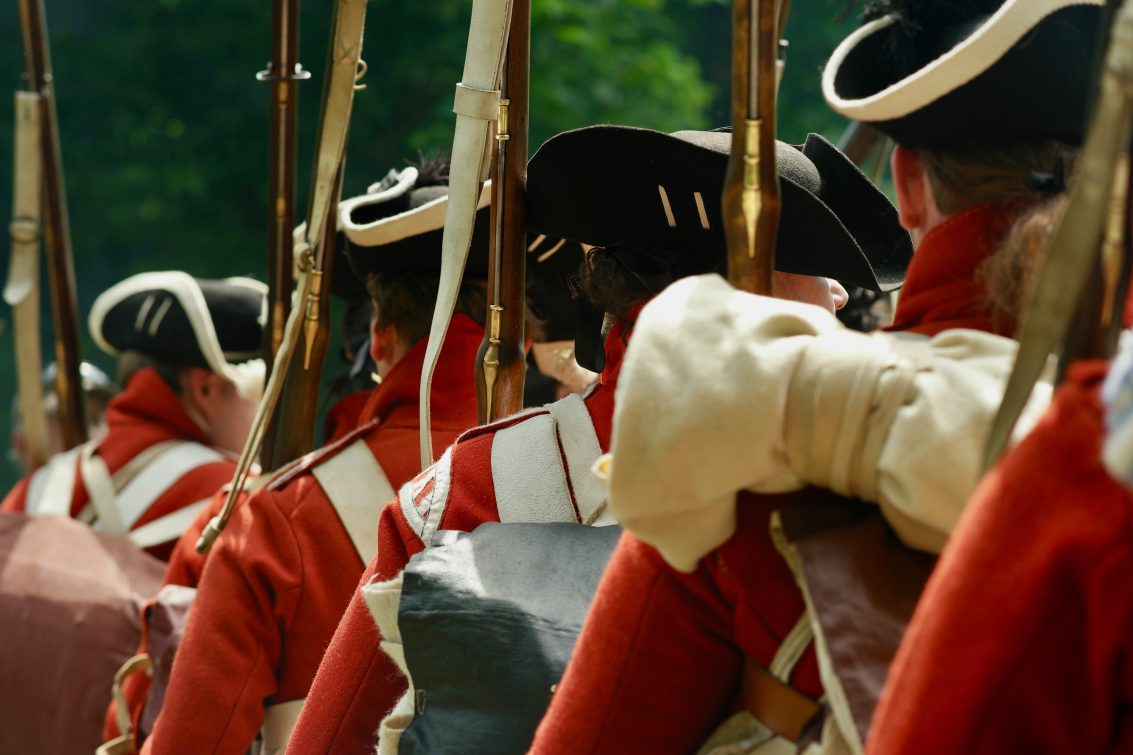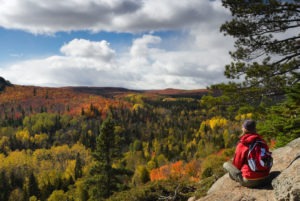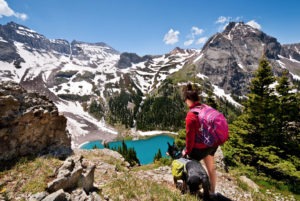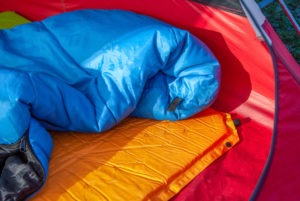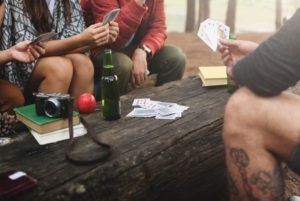Many of you will be kickin’ it at a campsite this 4th of July, stuffing your face with barbecue, brats, and beer. Camping is one of the best ways to celebrate our country’s history. Enjoying the freedom of summer, spending time in the outdoors our forefathers fought bravely to liberate, and doing all the things that make us uniquely American (muddin’ and deep-fried everything). Americans have been camping since the very beginning, so in honor of our nation’s birthday, we’re going to take a short look at what camping was like for those pesky rebels from the colonies.
Grab your gear
Continental soldiers were fitted to the teeth (in General Washington’s case, quite literally) with all kinds of gear to make their journey’s from one battlefield to another a little less miserable. Without modern transportation, much of what was needed to survive on the march had to be carried by the soldiers themselves.
On top of that, they had to bring things that we typically don’t take with us into the wilderness. Muskets, bayonets, powder horns, flints and a cartridge box packed with musket-balls, to name a few. If you’re camping with a black-powder musket, you do you, I guess. But there are plenty of items that we would take with us today.
The average Continental soldier was fitted first with a large knapsack, generally made of linen or canvas, that was worn similar to a backpack, where he would have carried bulkier items like clothing, razors, combs, and a tinderbox with flint to start fires. Over the shoulder, they carried a linen haversack for toting around smaller items like iron forks, pewter or horn spoons, knives, a plate, cups, coins, pipes, handkerchiefs and more. They might also carry writing utensils and paper for writing to loved ones back home. As he marched along muddy roads, through gnarled forests, and over hills, the Continental soldier could stay hydrated by drinking from a canteen. So far, your average revolutionary doesn’t look all that different from modern campers.
Sleep tight… and cold… and wet
After a long day of marching, nothing sounded better than setting up camp for the evening. The campsites of the Revolutionary War were a much drearier place than the cushy campsites we like to use. For starters, there were no amenities at all. No restrooms, no clean water (although the natural water was much cleaner than today), and probably worst of all, no gift shops! Unless you count looting local villages…
Instead, campsites were usually a place of misery, festering with disease, hunger and grisly wounds that were probably festering in their own right. The reason for this is largely that supply lines were difficult to manage and unreliable. There were no highways or reliable infrastructure, so roads were often muddy, blocked and rutted so terribly that pushing a supply-laden wagon through was out of the question. In other words, the army traveled faster on foot than supply could travel by wagon. Many soldiers went without their daily rations, had no reliable water source, no shelter, blankets, or anything else that makes camping fun and comfortable. But when supply was good, and the soldiers were provided with everything they were supposed to have, it may have looked more like a modern campsite.
Continental soldiers were provided with a large canvas tent that usually sheltered between 6 and 8 people. It would have looked something like what we call today a basic ridge tent. Men of higher rank, however, would have more comfortable lodging called a marquee, and was shared with fewer men. Here they’d keep all of the necessary war materials like maps, desks, chairs, candlesticks, and chests fit to burst with clothing, writing utensils, paper, wax, dining utensils, alcohol and other various items needed on the warfront. The private, however, would only have the things he could carry on his person.
Each soldier was issued a wool blanket that provided some shelter when tents weren’t available and were important for keeping off unwanted moisture. It could also be used as an overcoat if the soldier happened to not have one. Beyond tents and the gear they carried over their shoulders, the Continental soldiers had little else to make their lives more comfortable.
Pass the hardtack
Army-fare wasn’t near what it is today. Certainly not as luxurious what we get to eat on our 4th of July camping trips. I’m talking burgers, brats, hot dogs, fried chicken, potato salad, watermelon, you name it. But things weren’t wholly awful for soldiers in the Continental Army, at least with regards to food options (whether they actually received rations on a regular basis is another thing.)
When on the move, soldiers could munch on a type of hard bread or biscuit, often referred to as hardtack. He could also nibble on ears of corn, which were often provided. The supply wagons usually went in the front, so that when they stopped, soldiers could grab rations as they marched ahead to set up camp. After 1777, soldiers received one pound of flour or bread, 1 ½ pounds of beef or pork, and a much-needed quart of beer a day. Every week, he received 5 pints of peas, 1 pint of meal and 6 ounces of butter. Food was typically boiled or roasted. I can imagine that one could come up with some creative combinations with all of these items.
Capture the Cannonball?
The majority of the war for independence didn’t happen on the battlefield. Between every battle were weeks and months of marching, training, and milling about the campsite. With all that downtime, much like when we go camping, Continental soldiers played all kinds of games and sports to stay occupied.
In 1775, army regiments in Boston competed in a type of game that was designed to encourage soldiers when under enemy fire. Troops were rewarded for chasing down cannonballs fired from batteries in Boston. Men tripped and fell over one another as they raced to capture the cannonball first, creating an exciting opportunity for men to stay fit and active. The games had to be stopped however, because men were sticking out their feet to stop a rolling cannonball, and promptly getting them crushed to a pulp.
Soldiers engaged in all kinds of other, safer, sports during their downtime. Wrestling was fairly common although forbidden in many regiments. One record even tells of an American encampment at Winter Hill, who traveled to the camp at Prospect Hill, to challenge their best wrestler to a match. The invaders were reportedly defeated and the men of Prospect Hill celebrated, a symbolic victory if you ask me.
Ball sports were common as well, such as wicket, a form of cricket, as well as an ancestor to America’s pastime, baseball. There were other games as well, such as shinny, which was a relative of field hockey. Even our mighty first president was known to play ball every now and again. Francois Barbe-Marbois, a secretary to the French minister noted that “[Washington] sometimes throws and catches a ball for whole hours with his aides-de-camp.”
So the next time you’re tossing a football back and forth with your old-man on the 4th of July, remember that General Washington would have loved to join you.
Not all it’s cracked up to be
All of this doesn’t sound so bad, but in reality, what was offered was not often what soldiers got. Many of these men went without food for long periods of time. As mentioned earlier, it was difficult to properly supply the army, and this was especially true of the poorer southern states. The American colonies were dependant on the British for the majority of their imports, and since gold and silver were hard to come by, purchasing goods from other nations was doubly difficult. Combine that with British blockades and poor road conditions, it’s no surprise that supplying the army was an immense challenge.
Men often went without rations, resorting to hunting, fishing and looting local communities to fill their bellies. Similarly, men often went without a reliable shelter for their campsite. Tents were not always supplied, and the ones that were, were packed with more men than they could fit. One officer wrote, “What can be more cruel than crowding eight, ten, and twelve men into one tent, and oblige those that cannot get in, to sleep in the heavy dews?”
Furthermore, disease was absolutely rampant in the camps. With a lack of sanitary conditions, crowded hospitals, packed tents, and sleeping outdoors, disease spread rapidly and took the lives of many men. So if you were thinking to yourself, “Wow, what a fun time!”, it was not.
Despite all their hardships, the men and women of the Continental armies and militia endured 7 years of disease, famine, harsh weather, and war, eventually ousting the British forces after the Battle of Yorktown in 1781. So whether you’re hanging out on the pontoon, stretched out at the beach or enjoying a quiet weekend in the woods, it’s always good to remember the sacrifices made by the old Revolutionaries that have afforded you a beautiful country for which to camp; hopefully, with a few more amenities.
For more reading, check out these sources:
http://www.history.org/foundation/journal/autumn04/soldier.cfm
https://www.historyisfun.org/pdf/tea-overboard/Lifeofaprivate.pdf
http://library.la84.org/SportsLibrary/JSH/JSH1979/JSH0603/jsh0603d.pdf
